New Orleans was founded in 1718 by the French explorer Jean Baptiste de la Moyne who named it
La Nouvelle-Orléans
in honor of Philippe II, Duc d'Orléans, regent of France (1715–1723) during the minority of his nephew, Louis XIV.
In 1722 the French outpost north of the mouth of the Mississippi river
became the capital of the Louisiana colony, which at that time extended from the Gulf of Mexico in the South to Canada in the North and
from the Apalachian mountains in the East to the Rockies in the West. René-Robert Cavelier, Sieur de la Salle, had discovered the Mississippi basin in 1682.
The whole area was claimed for France in 1699 and named Louisiane for King Louis XIV. The French
possessions west of the Mississippi were secretely ceded to Spain in 1763 but were returned to France in 1800 (in exchange
with Tuscany in Italy, which was given to the Spanish Infanta and her husband, the Duke of Bourbon-Parma, as the Kingdom of Etruria).
After lengthy negotiations, President Thomas Jefferson purchased the area (828,000 square miles, 2.14 million square kilometers) from Napoleon in 1803.
The purchase price of 15 million US$ was heavily criticised at first because Congress had authorized Jefferson only to spend up to 2 million dollars
(intended for the purchase of the "Isle of New Orleans" only).
Nevertheless, the "Louisiana Purchase" (see map) was the largest single expansion of the American Territories.
The lands today make up the better part of
13 US states
(Louisiana, Arkansas, Missouri, Iowa, Minnesota, North and South Dakota, Nebraska, Kansas, Oklahoma, Montana, Wyoming, Colorado, and smaller parts of New Mexico, Texas, Mississippi and Florida).
In 1812 Louisiana was admitted to the Union as the 18th state.
New Orleans was the capital of the state of Louisiana until 1849, then again from 1865 to 1880.
During the Civil Wars, New Orleans seceded from the Union in 1861 and subsequently was occupied by Union troops until 1865 when the city joined the Union again.
In 1835 New Orleans was split into three separate communities, each with its own mayor and council. After 17 years the city
was reunited and other distinct townships (Lafayette, Jefferson City, Freeport) were eventually incorporated by 1870.
For 185 years New Orleans depended on an extensive system of canals (108 miles, 174 km) until they were made obsolete in 1914
by Baldwin Wood's mammoth pumping and drainage system. Today, New Orleans has a population of just under 500,000.
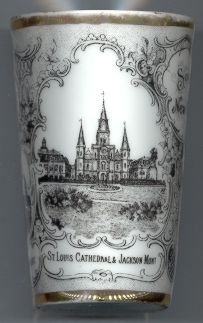
|
The  Cathedral of St. Louis King of France [centre] is located in
Jackson Square in the French Quarter. It is the oldest continuously operating Catholic cathedral of the United States.
It was originally built in 1724 and was rebuilt twice after a hurricane and a fire. The present church was dedicated
in 1794, rebuilt in 1849. The designation of a Basilica minor was bestowed upon it in 1964. Cathedral of St. Louis King of France [centre] is located in
Jackson Square in the French Quarter. It is the oldest continuously operating Catholic cathedral of the United States.
It was originally built in 1724 and was rebuilt twice after a hurricane and a fire. The present church was dedicated
in 1794, rebuilt in 1849. The designation of a Basilica minor was bestowed upon it in 1964.
(see also list of other basilicae minores depicted on glasses of this collection)
The  Cabildo [to the left of the cathedral] was built in 1795–1799 as the seat of the
Spanish municipal government in New Orleans.
The town council first met in its new hall, which it called the Casa Capitular (Capitol House), in 1799 and continued to meet there until Louisiana
became an American territory. They met in the room called the Sala Capitular (Capitol Room), which was the site for the Louisiana Purchase
transfers in 1803 and remained the principal meeting room for the new American city council until the 1850s.
In the 1840s an entire third story was added to the building, and massive cast-iron gates were erected at the main entrance.
It was established as the home of the Louisiana State Museum in 1911. In 1988 the Cabildo was severely damaged by fire. Over the next five years,
the landmark was authentically restored using 600-year-old French timber framing technology. It reopened to the public in 1994 with a comprehensive
exhibit focusing on Louisiana's early history. Cabildo [to the left of the cathedral] was built in 1795–1799 as the seat of the
Spanish municipal government in New Orleans.
The town council first met in its new hall, which it called the Casa Capitular (Capitol House), in 1799 and continued to meet there until Louisiana
became an American territory. They met in the room called the Sala Capitular (Capitol Room), which was the site for the Louisiana Purchase
transfers in 1803 and remained the principal meeting room for the new American city council until the 1850s.
In the 1840s an entire third story was added to the building, and massive cast-iron gates were erected at the main entrance.
It was established as the home of the Louisiana State Museum in 1911. In 1988 the Cabildo was severely damaged by fire. Over the next five years,
the landmark was authentically restored using 600-year-old French timber framing technology. It reopened to the public in 1994 with a comprehensive
exhibit focusing on Louisiana's early history.
[Text modified from http://lsm.crt.state.la.us/]
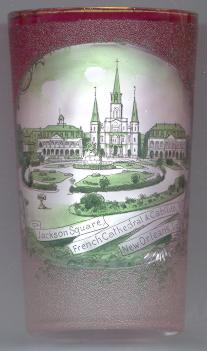
|
The  Presbytere [to the right of the cathedral] was built in 1791–1795.
Originally called the Casa Curial (Ecclesiastical House), it was built as a home for the Capuchin monks.
The second floor, however, was not completed until 1813 when the Wardens of the Cathedral assumed responsibility for the final phase.
The building initially was used for commercial purposes until 1834 when it became a courthouse. In 1847 the mansard roof was added.
The Presbytere was then used by the city as a courthouse until 1911 when it became part of the Louisiana State Museum. Presbytere [to the right of the cathedral] was built in 1791–1795.
Originally called the Casa Curial (Ecclesiastical House), it was built as a home for the Capuchin monks.
The second floor, however, was not completed until 1813 when the Wardens of the Cathedral assumed responsibility for the final phase.
The building initially was used for commercial purposes until 1834 when it became a courthouse. In 1847 the mansard roof was added.
The Presbytere was then used by the city as a courthouse until 1911 when it became part of the Louisiana State Museum.
[Text modified from http://lsm.crt.state.la.us/]
The  Jackson monument [centre, barely visible] was unveiled in 1856
in the centre of Jackson Square (which had been renamed in 1850 from Place d'Armes). The monument was erected
in honour of Major General Andrew Jackson (1767–1845), hero of the Battle of New Orleans (1815) causing a decisive defeat of the British who
subsequently had to recognize the US claims to Louisiana and West Florida, and 7th President (1829–1837) of the United States.
The bronze monument (14 ft tall, weighing 15 tons, assembled of 60 pieces) created by the sculptor Clark Mills is a not so frequent example
of an equestrian monument supported by the two hind legs only.
The monument is a copy of the Jackson monument erected in Washington, DC, in 1853.
A third copy was created for Nashville, Tennessee. Jackson monument [centre, barely visible] was unveiled in 1856
in the centre of Jackson Square (which had been renamed in 1850 from Place d'Armes). The monument was erected
in honour of Major General Andrew Jackson (1767–1845), hero of the Battle of New Orleans (1815) causing a decisive defeat of the British who
subsequently had to recognize the US claims to Louisiana and West Florida, and 7th President (1829–1837) of the United States.
The bronze monument (14 ft tall, weighing 15 tons, assembled of 60 pieces) created by the sculptor Clark Mills is a not so frequent example
of an equestrian monument supported by the two hind legs only.
The monument is a copy of the Jackson monument erected in Washington, DC, in 1853.
A third copy was created for Nashville, Tennessee.
[Text modified from http://lsm.crt.state.la.us/]
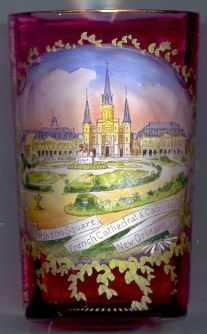
|
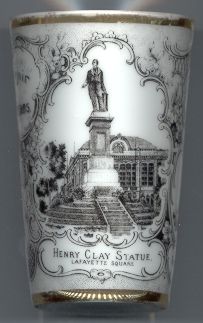
|
The  Henry Clay statue [left] was erected in 1860 in honour of
Henry Clay (1777–1852), the Kentucky statesman who helped to pacify and preserve the nation during the Civil wars.
The original location of the statue was at the crossing of Royal and Canal Street. In 1901 it had become an obstacle for the traffic
and was moved to Lafayette Square (as a consequence the Franklin monument had to move to the Camp Street side of the square). Henry Clay statue [left] was erected in 1860 in honour of
Henry Clay (1777–1852), the Kentucky statesman who helped to pacify and preserve the nation during the Civil wars.
The original location of the statue was at the crossing of Royal and Canal Street. In 1901 it had become an obstacle for the traffic
and was moved to Lafayette Square (as a consequence the Franklin monument had to move to the Camp Street side of the square).
The  Robert E. Lee monument [right] was erected in 1884 in St. Charles Street
in honour of General Lee (1807–1870), commanding Confederate general. The bronze statue (height 15 ft, 4.6 m) is supported
by a Doric marble column (the total height of the monument is 106 ft, 32 m). Robert E. Lee monument [right] was erected in 1884 in St. Charles Street
in honour of General Lee (1807–1870), commanding Confederate general. The bronze statue (height 15 ft, 4.6 m) is supported
by a Doric marble column (the total height of the monument is 106 ft, 32 m).
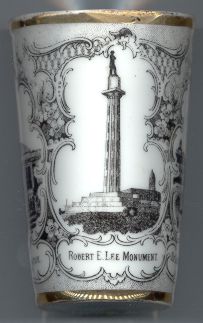
| | | |


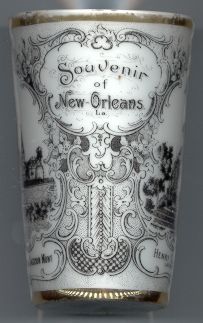





![[scale]](lineal.jpg)